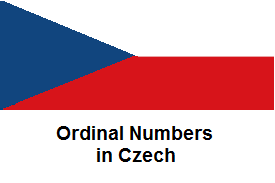Difference between revisions of "Language/Czech/Vocabulary/Ordinal-Numbers-in-Czech"
< Language | Czech | Vocabulary
Jump to navigation
Jump to search
m (Quick edit) |
m (Quick edit) |
||
| Line 165: | Line 165: | ||
|} | |} | ||
== | ==Other Lessons== | ||
* [[Language/Czech/Vocabulary/Days-of-the-Week|Days of the Week]] | * [[Language/Czech/Vocabulary/Days-of-the-Week|Days of the Week]] | ||
* [[Language/Czech/Vocabulary/Health|Health]] | * [[Language/Czech/Vocabulary/Health|Health]] | ||
| Line 176: | Line 176: | ||
* [[Language/Czech/Vocabulary/Parts-of-the-Body|Parts of the Body]] | * [[Language/Czech/Vocabulary/Parts-of-the-Body|Parts of the Body]] | ||
* [[Language/Czech/Vocabulary/Count-to-10|Count to 10]] | * [[Language/Czech/Vocabulary/Count-to-10|Count to 10]] | ||
<span links></span> | |||
Latest revision as of 23:12, 26 March 2023
How to form the Ordinal Numbers in Czech[edit | edit source]
Ordinal numbers are used to indicate the position of an object in a sequence. In Czech, ordinal numbers are formed by adding the suffix "-tý" to the cardinal number, with some exceptions.
Here's how to form the ordinal numbers in Czech:
For numbers ending in "-1", add the suffix "-ý". For example:[edit | edit source]
- První (first)
- Jednadvacátý (twenty-first)
- Sto první (one hundred first)
For numbers ending in "-2" through "-4", add the suffix "-í". For example:[edit | edit source]
- Druhý (second)
- Třetí (third)
- Čtyřiadvacátý (twenty-fourth)
For all other numbers, add the suffix "-tý". For example:[edit | edit source]
- Desátý (tenth)
- Padesátý (fiftieth)
- Tisící (thousandth)
Note that some numbers have irregular forms. Here are a few examples:
- Dvacet (twenty) becomes dvacátý (twentieth)
- Padesát (fifty) becomes padesátý (fiftieth)
- Šest (six) becomes šestý (sixth)
Remember that ordinal numbers in Czech must agree in gender and case with the noun they modify. For example:
- První den (the first day, masculine)
- První hodina (the first hour, feminine)
- První místo (the first place, neuter)
That's it for forming ordinal numbers in Czech. Practice these rules and you'll be able to use them with ease in no time!
Czech Ordinal Numbers from 1 to 100[edit | edit source]
| NUMBER | MASCULINE | FEMININE | NEUTRAL |
|---|---|---|---|
| 01 | PRVNÍ | PRVNÍ | PRVNÍ |
| 02 | DRUHÝ | DRUHÁ | DRUHÉ |
| 03 | TŘETÍ | TŘETÍ | TŘETÍ |
| 04 | ČTVRTÝ | ČTVRTÁ | ČTVRTÉ |
| 05 | PÁTÝ | PÁTÁ | PÁTÉ |
| 06 | ŠESTÝ | ŠESTÁ | ŠESTÉ |
| 07 | SEDMÝ | SEDMÁ | SEDMÉ |
| 08 | OSMÝ | OSMÁ | OSMÉ |
| 09 | DEVÁTÝ | DEVÁTÁ | DEVÁTÉ |
| 10 | DESÁTÝ | DESÁTÁ | DESÁTÉ |
| 11 | JEDENÁCTÝ | JEDENÁCTÁ | JEDENÁCTÉ |
| 12 | DVANÁCTÝ | DVANÁCTÁ | DVANÁCTÉ |
| 13 | TŘINÁCTÝ | TŘINÁCTÁ | TŘINÁCTÉ |
| 14 | ČTRNÁCTÝ | ČTRNÁCTÁ | ČTRNÁCTÉ |
| 15 | PATNÁCTÝ | PATNÁCTÁ | PATNÁCTÉ |
| 20 | DVACÁTÝ | DVACÁTÁ | DVACÁTÉ |
| 30 | TŘICÁTÝ | TŘICÁTÁ | TŘICÁTÉ |
| 40 | ČTYŘICÁTÝ | ČTYŘICÁTÁ | ČTŘICÁTÉ |
| 50 | PADESÁTÝ | PADESÁTÁ | PADESÁTÉ |
| 60 | ŠEDESÁTÝ | ŠEDESÁTÁ | ŠEDESÁTÉ |
| 70 | SEDMDESÁTÝ | SEDMDESÁTÁ | SEDMDESÁTÉ |
| 80 | OSMDESÁTÝ | OSMDESÁTÁ | OSMDESÁTÉ |
| 90 | DEVADESÁTÝ | DEVADESÁTÁ | DEVADESÁTÉ |
| 100 | STÝ | STÁ | STÉ |
Other Lessons[edit | edit source]
- Days of the Week
- Health
- Food
- Election
- Beverages
- Birthday
- Greetings
- Useful phrases
- Parts of the Body
- Count to 10
